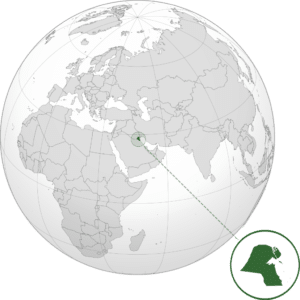Introduction:
Kuwait, officially the State of Kuwait, is a country in Western Asia. Situated in the northern edge of Eastern Arabia at the tip of the Persian Gulf, it borders Iraq to the north and Saudi Arabia to the south. As of 2016, Kuwait has a population of 4.5 million people: 1.3 million are Kuwaitis and 3.2 million are expatriates. Expatriates account for approximately 70% of the population.

Oil reserves were discovered in commercial quantities in 1938. In 1946, crude oil was exported for the first time. From 1946 to 1982, the country underwent large-scale modernization. In the 1980s, Kuwait experienced a period of geopolitical instability and an economic crisis following the stock market crash. In 1990, Kuwait was invaded, and later annexed, by Saddam’s Iraq. The Iraqi occupation of Kuwait came to an end in 1991 after military intervention by a military coalition led by the United States. Kuwait is a non-NATO ally of the United States. Kuwait is also a major ally of ASEAN, while maintaining a very strong relationship with China.
Kuwait is a constitutional sovereign state with a semi-democratic political system. Kuwait has a high-income economy backed by the world’s sixth largest oil reserves. The Kuwaiti dinar is the highest valued currency in the world. According to the World Bank, the country has the nineteenth highest per capita income. The Constitution was promulgated in 1962.

Kuwait is home to the largest opera house in the Middle East. The Kuwait National Cultural District is a member of the Global Cultural Districts Network.
History:
Early History:
In 1613, the town of Kuwait was founded in modern-day Kuwait City. Administratively, it was a sheikhdom, ruled by local sheikhs. In 1716, the Bani Utub settled in Kuwait, which at this time was inhabited by a few fishermen and primarily functioned as a fishing village. In the eighteenth century, Kuwait prospered and rapidly became the principal commercial center for the transit of goods between India, Muscat, Baghdad and Arabia. By the mid 1700s, Kuwait had already established itself as the major trading route from the Persian Gulf to Aleppo.

During the Persian siege of Basra in 1775–79, Iraqi merchants took refuge in Kuwait and were partly instrumental in the expansion of Kuwait’s boat-building and trading activities. As a result, Kuwait’s maritime commerce boomed, as the Indian trade routes with Baghdad, Aleppo, Smyrna and Constantinople were diverted to Kuwait during this time. The East India Company was diverted to Kuwait in 1792. The East India Company secured the sea routes between Kuwait, India and the east coasts of Africa. After the Persians withdrew from Basra in 1779, Kuwait continued to attract trade away from Basra.
Kuwait was the center of boat building in the Persian Gulf region. During the late eighteenth and nineteenth centuries, vessels made in Kuwait carried the bulk of trade between the ports of India, East Africa and the Red Sea.
